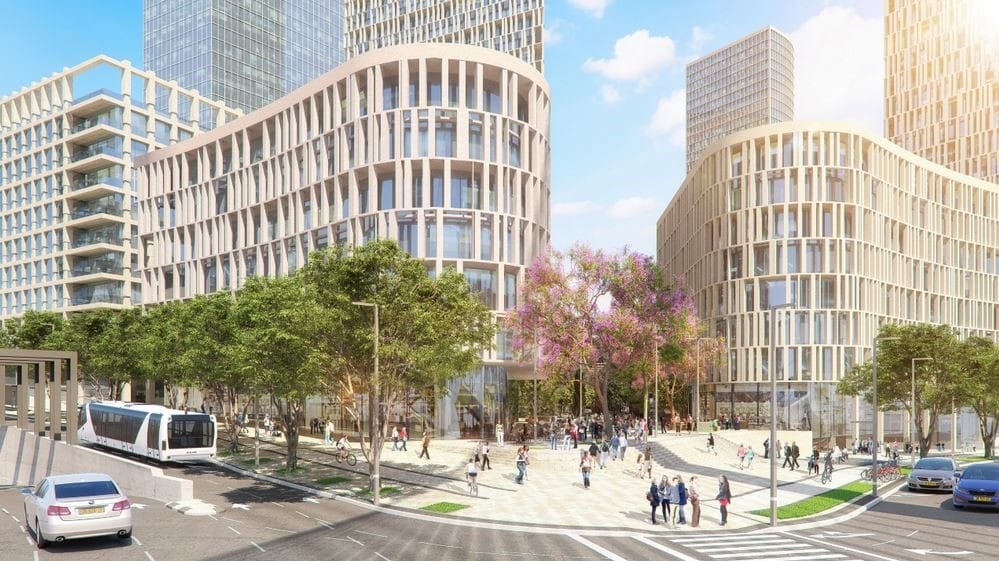Jerusalem's Technological Renaissance: A Tapestry of Transformative Projects
Discover how Jerusalem is undergoing a technological renaissance with a diverse array of transformative projects, from the ambitious Jerusalem Gateway Project to the innovative HUJITECH initiative.

Jerusalem, often regarded as one of the most historically significant cities in the world, is undergoing a transformation with the ambitious Jerusalem Gateway Project. This initiative, aimed at revitalizing the entrance to the ancient city, represents a bold step forward in urban development, blending modernity with Jerusalem's rich cultural heritage.
A Vision for the Future
At the heart of the Jerusalem Gateway Project lies a vision to create a vibrant, dynamic urban center that reflects the spirit of innovation while respecting the city's historical significance. Spearheaded by city planners and developers, the project seeks to transform the gateway into a hub of activity, commerce, and connectivity.
Enhancing Infrastructure
Central to the project is the enhancement of transportation infrastructure. This includes the expansion and modernization of roads, the development of new public transportation networks, and the integration of smart technology to improve traffic flow and accessibility. By investing in efficient transportation systems, the project aims to ease congestion and improve connectivity, making it easier for residents and visitors to navigate the city.
Creating Commercial and Residential Spaces
The Jerusalem Gateway Project also encompasses the development of commercial and residential spaces. New office buildings, shopping centers, and entertainment venues are being constructed, offering opportunities for businesses to thrive and residents to enjoy a diverse range of amenities. Additionally, modern residential complexes are being built to accommodate the city's growing population, providing high-quality housing options in close proximity to urban conveniences.

Preserving Cultural Heritage
Despite its focus on modernization, the Jerusalem Gateway Project remains committed to preserving the city's cultural heritage. Efforts are underway to ensure that development projects are carried out sensitively, respecting the historical significance of the area and preserving architectural landmarks. By striking a balance between progress and preservation, the project aims to celebrate Jerusalem's rich history while embracing its future potential.
Fostering Economic Growth
Beyond its architectural and infrastructural developments, the Jerusalem Gateway Project is expected to stimulate economic growth and investment in the region. By creating new business opportunities, attracting tourists, and generating employment, the project aims to contribute to the economic prosperity of Jerusalem and its surrounding areas. Additionally, by positioning Jerusalem as a modern, attractive destination, the project seeks to enhance the city's global reputation and appeal.
Community Engagement and Sustainability
Throughout the planning and implementation phases, community engagement and sustainability are prioritized. Local residents, businesses, and stakeholders are consulted to ensure that their voices are heard and their needs are met. Furthermore, environmental considerations are integrated into every aspect of the project, with a focus on sustainable design, green spaces, and energy-efficient technologies.
As the Jerusalem Gateway Project unfolds, its impact can be quantified through various numbers, highlighting the scale and significance of this transformative initiative:
1,200,000 Square Meters: This vast expanse encompasses the planned development area for offices, commerce, hotels, public spaces, and residential buildings. It symbolizes the magnitude of the project's scope, offering a diverse array of amenities and facilities to cater to the needs of residents and visitors alike.
350,000 Pedestrians Per Day: With the implementation of improved infrastructure and transportation networks, the project aims to accommodate a significant influx of pedestrians daily. This statistic underscores the project's focus on enhancing accessibility and promoting walkability within the urban environment.
60,000 New Employment Opportunities: One of the primary objectives of the Jerusalem Gateway Project is to stimulate economic growth and create job opportunities for the local community. This impressive figure reflects the project's potential to generate employment across various sectors, fostering prosperity and livelihoods for residents.
32 Minutes: With the introduction of an efficient train service, the project benefits of the significantly reduce travel time between Tel Aviv and Jerusalem. Cutting the commute to just 32 minutes not only enhances connectivity between these two major cities but also facilitates greater mobility and accessibility for commuters and travelers.
20 Towers Up to 40 Stories High: The skyline of Jerusalem is set to undergo a dramatic transformation with the construction of towering structures reaching up to 40 stories in height. These iconic landmarks will not only redefine the city's skyline but also provide modern living and working spaces, contributing to its urban evolution.
3 Light Rail Lines - Red, Green, Yellow: The implementation of three new light rail lines represents a substantial investment in public transportation infrastructure. These lines, distinguished by their colors, will serve as vital arteries connecting different parts of the city, facilitating seamless travel and reducing dependency on private vehicles.
These numbers encapsulate the scale, ambition, and potential impact of the Jerusalem Gateway Project, illustrating its role in shaping the future of Jerusalem as a modern, dynamic, and inclusive metropolis.




The HUJITECH project
Jerusalem Gateway Project it's not the only major project reshaping the landscape of Jerusalem. The city is witnessing a surge of transformative initiatives aimed at enhancing infrastructure, fostering economic growth, and preserving its cultural heritage. Let's explore another noteworthy project that is making waves in Jerusalem's development scene. In a groundbreaking partnership led by the Jerusalem Development Authority (JDA), the Jerusalem Municipality, and the Hebrew University, plans have been set in motion to establish HUJITECH, a state-of-the-art hi-tech industrial park located on the prestigious Safra Campus. This visionary project, awarded to the Gav-Yam company through a competitive tender process, aims to catalyze innovation, research, and economic growth within Jerusalem and beyond.
Strategic Planning and Partnership
The collaborative efforts of the JDA, the Jerusalem Municipality, and the Hebrew University have been instrumental in shaping the vision for HUJITECH. Through meticulous planning and foresight, a framework has been established to create a dynamic ecosystem where academia and industry converge to drive technological advancements and entrepreneurial endeavors.
Under the stewardship of the Gav-Yam company, the park will be developed, rental spaces marketed, and facility management overseen for an initial period of 49 years, with the potential for an extension of an additional 49 years. This long-term commitment underscores the dedication to fostering sustained growth and innovation within the industrial park.
Phased Development
HUJITECH will be established in two stages, with the first phase encompassing three buildings spanning a total area of 127,000 square meters. This initial phase lays the groundwork for collaboration and growth, providing a robust infrastructure to support the diverse needs of companies and researchers alike.
Building upon the success of the first phase, the second stage will introduce an additional tower, further expanding the park's footprint to accommodate the growing demand for innovation-driven spaces. With a total area of 140,000 square meters, this expansion represents a significant opportunity to attract leading enterprises and startups seeking to capitalize on Jerusalem's vibrant ecosystem.
Fostering Collaboration and Integration
HUJITECH represents a paradigm shift in Israel's approach to innovation, facilitating direct integration and interfaces between research conducted on the Safra Campus and the companies based within the park. This unique model offers unprecedented opportunities for collaboration, knowledge exchange, and commercialization of research findings.
One of the key advantages of HUJITECH is the rich ecosystem cultivated on the Safra Campus, characterized by a fusion of academic excellence, cutting-edge research facilities, and a spirit of entrepreneurship. By leveraging this unique environment, the park aims to maximize the potential for synergy between academia and industry, driving breakthroughs and advancements across various sectors.
Economic Impact and Job Creation
The establishment of HUJITECH is expected to have a significant economic impact, creating approximately 5,000 new jobs within the region. This influx of employment opportunities will not only drive economic growth but also foster talent retention and attract skilled professionals to Jerusalem's burgeoning tech scene.
Collectively, these transformative projects underscore Jerusalem's resilience, vision, and commitment to shaping a brighter future for its residents and visitors alike.






